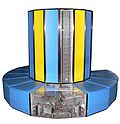Cray XC50
The Cray XC50 is a massively parallel multiprocessor supercomputer manufactured by Cray.[1] The machine can support Intel Xeon processors, as well as Cavium ThunderX2 processors, Xeon Phi processors and NVIDIA Tesla P100 GPUs.[2] The processors are connected by Cray's proprietary "Aries" interconnect, in a dragonfly network topology.[1] The XC50 is an evolution of the XC40, with the main difference being the support of Tesla P100 processors and the use of Cray software release CLE 6 or 7.[3]
Deployed Cray XC50 systems[edit]
Australia[edit]
- Bureau of Meteorology deployed a combined XC50 and CS500 platform. [4]
India[edit]
- Indian Institute of Technology, Bombay (IITB) has deployed a Cray XC50 system named Spacetime with a peak performance of 1 petaflops coupled with Cray ClusterStor L300 Lustre storage system.[5]
Japan[edit]
- The Japanese National Institutes for Quantum and Radiological Science and Technology has deployed on 2018 26th July a XC50 to support the ITER fusion project.[6] At deployment, it will not be as fast as the Swiss Piz Daint computer; however, it is predicted as one of the top 30 supercomputers in the world, and the fastest available to fusion researchers.[6]
- The Japan Meteorological Agency is planning to deploy 2 Cray XC50s to help with weather forecasting.[7] The systems will be deployed with the assistance of Cray and Hitachi.
- The Center for Computational Astrophysics at the National Astronomical Observatory of Japan have deployed a XC50 named ATERUI II, named after a Japanese chief.[8][9][10] It has 40,200 Xeon cores, with a peak performance of 3.087 petaflops.[9][11]
- The Railway Technical Research Institute (RTRI) will install five XC50 cabinets and a 720 TB Cray ClusterStor L300 for storage to gain insights on rail transportation. This is their third Cray machine after acquiring an XC30 and CS300, both in 2013.[12]
- Yokohama City University has selected the air-cooled XC50-AC for life sciences research.[13]
New Zealand[edit]
- New Zealand Science Infrastructure (NeSI) is deploying a XC50 at their High Performance Computing Facility in Wellington.[14]
South Korea[edit]
- The Institute for Basic Science (IBS) is installing a 1.43-petaflop XC50, named Aleph, for climate physics research.[15][12][16][17]
Switzerland[edit]
- The Swiss National Supercomputing Centre in Lugano has a 361,760-core XC50 called Piz Daint.[18] This has been upgraded from a Cray XC30 and Cray XC40 configurations.
United Kingdom[edit]
- Cray is developing a XC50 system with ARM processors called Isambard.[19][20] This will be used for a consortium of Bristol, Bath, Cardiff and Exeter universities.[20]
References[edit]
- ^ a b Ferreira, Bruno (14 November 2016). "Cray XC50 supercomputer can probably run Crysis". The Tech Report. Retrieved 2 June 2018.
- ^ Feldman, Michael (13 November 2017). "Cray Adds ARM Option to XC50 Supercomputer". Top 500. Retrieved 2 June 2018.
- ^ Feldman, Michael (14 November 2016). "Cray Unveils XC50 Supercomputer, Swiss Get First Look". Top 500. Retrieved 5 June 2018.
- ^ "Bureau of Meteorology shuts oldest data centre after 46 years". 2020-10-26.
- ^ staff (2018-07-05). "IIT Bombay deploys Cray XC50 Supercomputer". insideHPC. Retrieved 2021-03-11.
- ^ a b Dent, Steve (19 March 2018). "Japan's latest supercomputer is dedicated to nuclear fusion". Engadget. Retrieved 2 June 2018.
- ^ "Japan Meteorological Agency to deploy Two Cray XC50 Supercomputers". Inside HPC. 21 May 2018. Retrieved 2 June 2018.
- ^ "Supercomputer Astronomy: The Next Generation". Centre for Computational Astrophysics - National Astronomical Observatory of Japan. Retrieved 25 June 2018.
- ^ a b Brueckner, Rich (4 June 2018). "Cray Deploys 3 Petaflop ATERUI II supercomputer at CfCA in Japan". Inside HPC. Retrieved 5 June 2018.
- ^ Feldman, Michael (4 June 2018). "World's Most Powerful Supercomputer for Astronomy Begins Operation". Top 500. Retrieved 25 June 2018.
- ^ Bennett, Jay (1 June 2018). "The Fastest Supercomputer for Astronomy Comes Online in Japan". Popular Mechanics. Retrieved 25 June 2018.
- ^ a b Feldman, Michael (20 September 2018). "Cray Picks Up Two Supercomputer Wins in Asia". TOP500. Retrieved 26 November 2018.
- ^ "Japan's Yokohama City University Selects Cray XC50-AC Supercomputer for Life Sciences Research". Globe Newswire. Cray, Inc. 20 September 2017. Retrieved 5 June 2018.
- ^ "NeSI in New Zealand Installs Pair of Cray Supercomputers". Inside HPC. 19 August 2017. Retrieved 5 June 2018.
- ^ "Institute for Basic Science (IBS) - TOP500 Supercomputer Sites". TOP500. November 2018. Retrieved 28 November 2018.
- ^ "Cray XC50 Supercomputer coming to Institute for Basic Science in South Korea". www.InsideHPC.com. 20 September 2018. Retrieved 26 November 2018.
- ^ "PNU's IBS Center for Climate Physics boosts climate research with new Supercomputing Facility". IBS Center for Climate Physics. Institute for Basic Science. Archived from the original on 26 November 2018. Retrieved 26 November 2018.
- ^ "Top 500 - Piz Daint". Top 500. Retrieved 25 June 2018.
- ^ Hemsoth, Nicole (13 November 2017). "CRAY ARMS HIGHEST END SUPERCOMPUTER WITH THUNDERX2". The Next Platform. Retrieved 2 June 2018.
- ^ a b Feldman, Michael (8 May 2018). "Cavium Releases ThunderX2 ARM Processor". Top 500. Retrieved 2 June 2018.

